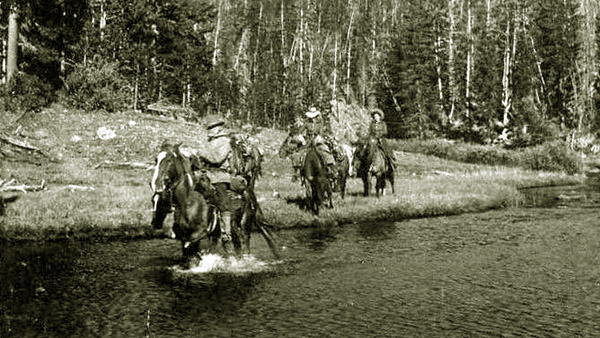
Hunter and daughter heading home from the hunt near Dubois, approx. 1903
Dubois early became popular with big game huners, particularly with those hunting Big Horn Sheep. The Ramshorn
Peak area was noted as the prime area for big horn in the United States. It was,
however, difficult of access entailing even after the railroad reached Lander a 100 mile long stage coach ride. Prior to the arrival of
passenger service to Lander in 1922, it required almost a 200 mile trip by wagon or stage from Casper. In 1889, Bryant B. Brooks, owner of the V Bar V ranch on the Big Muddy, needed six weeks
to escort a party of hunters into the Wind Rivers above Dubois. Brooks in a description of the trip from Casper to Dubois retorically asked,
"Do you know about the 150 mile stretch between Casper and Lander? If not you have missed nothing."
Brooks later became Governor (January 1905-January 1911). The party was outfitted in Casper and the party rode horseback the 200 miles. The
gear was carried in a mess wagon pulled by four mules with "Post Hole Jack" McGrath on the ribbons. A cook and a wrangler also
accompanied the party. On the trip, the hunters killed some eight bear including one grizzly.
When the grizzly reared up all three hunters fired. When the bear was skinned there was only one bullet hole and one bullet.
All three claimed that it was theirs.
Post Hole Jack was one of the first hands hired by Brooks after he established the V Bar V on the Big Muddy east of Casper (not to be confused with the V Bar V in Hoback). McGrath received the moniker
when as a greenhorn on the ranch he was instructed by Brooks to dig a line of post holes in a straight line eastward until he was told to stop.
Forgetting the instructions that he had given, Brooks left for Chicago, then for ranchmen in north central and central Wyoming the center of the Universe. Allegedly, depending upon who is telling the story,
McGrath continued eastward either into the next spread or, according to one version, clear into Nebraska. Not withstanding the nickname, McGrath became a business associate of Governor Brooks, prominent in the affairs of the
Natrona County Democrat Party and active in the Masonic Blue Lodge, the Shrine, and the Eastern Star. It may be, however, that the name stuck because there were in the early 1900's at least three
John McGraths in Natrona county, "Black Jack" McGrath who at one time ran the Grand Central Hotel;
"Red Jack" McGrath who was a blacksmith. Post Hole Jack achieved imortality when Lee Smokey Garretson and the Rustic Ramblers over in Worland recorded a "45" record in the mid-1960's, "Where They Buried Post-Hole Jack." The song is about a
cowboy who lookings for a place to spread his bed roll, lays it out in a small clearing a little over six feet long. Through the night the cowboy was unable to sleep, some critter in the bed roll made him dream he was riding a bronc. The song
concludes:
But the dawn came up like thunder, and I saw Wyoming's face
In the light I ceased to wonder at the cause of my disgrace
Though it weren't real surprising when I rolled the bed tarp back
For then I seen the mound a risin' where they buried Posthole Jack.
As discussed below, Brooks' hunting trip later became significant for tourism in the area because it was on that
trip that Brooks Lake 23 miles west of Dubois was discovered.
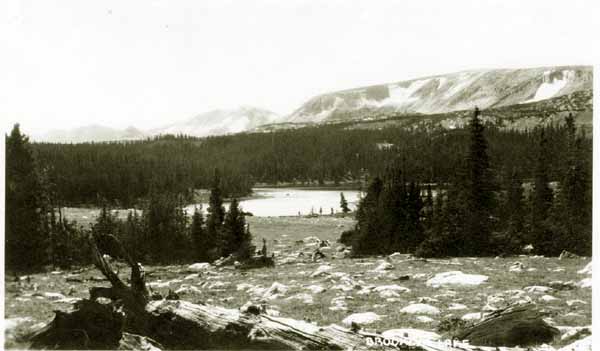
Brooks Lake, undated.
Not withstanding the distance and difficulty of travel, catering to hunting became a significant source of income in the
Dubois area. The 1917 Report of the State Game Warden listed 22 licensed guides in Dubois. Not listed, but extolled in a an article by Mark Hodgson, "Five Busy Days After Bighorns,"
Recreation Magazine, November, 1917, was Hugh B. Livingston (1889-1967). Eugene Amoretti, according to Hopkins, wrote that Livingston was one of the best guides.
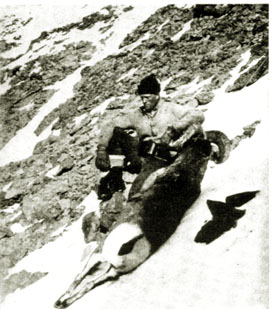 . . . . . .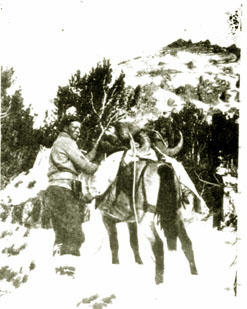
Hugh Livingston with Big Horn sheep near Ramshorn Peak, 1916. Photo by Mark Hodgseon
The area is a hapitat for lynx, grizzly, elk, wolf, and coyote. At an early point in time,
the area was actively promoted for hunting by professional guide and writer A. C. Rowell.
Rowell estimated the "best game country in Wyoming is the country on, and adjacent to, the
head waters of the Wind River." Dubois, according to Rowell, was
"literally in the game country."
Rowell continued:
I have stood on the street of Dubois (It has only one about 100 feet long.) and counted four bands of
elk in sight on the hills at one time. Hunter-Trader-Trapper,"Opportunity for Sport in Wyoming," Vol. 29, p. 40 at 42, 1911.
Rowell bragged that he had got a bear or several each season and had "killed eleven bears and saw thousands
of elk, hunded of deer and a good many big horn sheep.
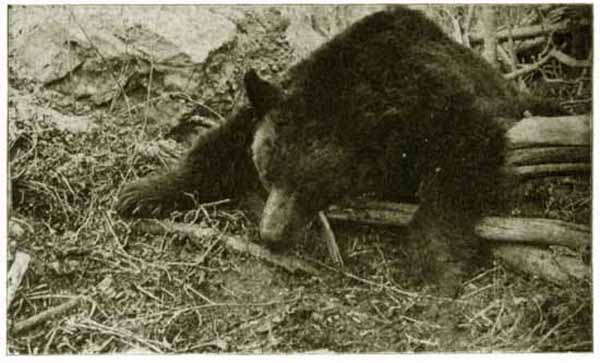
Bear killed by A. C. Rowell, approx. 1911.
Conflict between man and grizzly was and remains continuing. Rowell, himself contended that grizzlies only attacked when provoked or out
of memory of a prior conflict between man and beast. In 1920, one 1,000 lb grizzly named
"Silver Tip" was finally killed after having done
some $50,000 (in 1920 dollars) damages over a five year period.
He was finally trapped after hunters followed a
trail of fifteen dead cattle all with their livers removed. Over the years attacks on
cattle continued. In 1993, the Walton Ranch Co., which customarily grazed in the
Togwotee Pass area lost some 32 head to bear. Over a six year period Walton lost at estimated
108 head. The Waltons moved their grazing to Idaho. Dan Ingalls & Sons also lost cattle.
Grizzlies also attacked man. Several hunters had broken skulls. One lost his jaw. Bicyclists crossing the
pass were attacked and escaped only by the use of pepper spray. The ursine retreated when the bicyclists estimated they only had
one second of spray left. Conflict also existed between the Wyoming Deparment of Transportation and conservationists over the
road. Because of its hazardous nature, the Department began consideration of widening or relocating segments of the
highway in the early 2000's. The project which commenced in 2008 will be the most expensive highway project ever undertaken in
Wyoming.
Tourism, however, did not become important until about 1922. Tourism in Dubois was in reality dependent upon passage over Togwotee Pass, elevation 9,658 feet.
The Pass was first opened to motor cars in 1917. Beginning in 1919 through 1921, the road was rebuilt and graveled.
Nevertheless, travel over the rebuilt road remained difficult. The dedication of the
newly rebuilt road was a major event. Various parties including Yellowstone Park Superintendent H. M.
Albright driving his own "high powered" car followed by two of the yellow tour busses used in the Park, Governor
Robert Carey, railroad officials, Emerson Hough and Maxwell Struthers Burt, both writers for the
Saturday Evening Post, all gathered in Lander to drive over the new road. At the end of the
first day, the parade of cars had made the ninety miles to Dubois. The following day, the cars proceded over the
pass to Moran. The autos were trailed by two helper cars and a large truck carrying gasoline and oil. Although the Rawlins Republican,
September 8, 1921, described the
road as being in "excellent condition," some of the cars had to have assistance in making the steep grade. Others turned back
from Dubois. In 1922, The Chicago and Northwestern began passenger service to Lander. It was hoped that this would provide an opportunity for a
fourth entrance to Yellowstone Park. Most of the tourists to the park arrived by train to one of the three entrances: Gardiner, Cody, or West Yellowstone. Motor transportation still in its infancy was
gnerally through Cody or West Yellowstone. As discussed with regard to Jackson a route through the Grand Tetons was impractical.
The reality was that tourists to Yellowstone had to go through
Montana or Idaho. In anticipation of the hordes of visitors the Amoretti Hotel and Camp Company was formed. The Company constructed two hotels, one at
Brooks Lake twenty-three miles west of Dubois and the second at Moran Junction in Jackson Hole. Additionally, the company operated a number of tent camps. For the most part, however, the
tent camps could only be reached by horseback. Additionally, the Lander-Yellowstone Transportation Company was incorporated to provide transportation to Yellowstone from the
train station at Lander with an overnight stop at the Brooks Lake Lodge and lunch at Moran.
Advertisements promised a "ride through a senic wonderland in a comfortable high-powered motor stage."
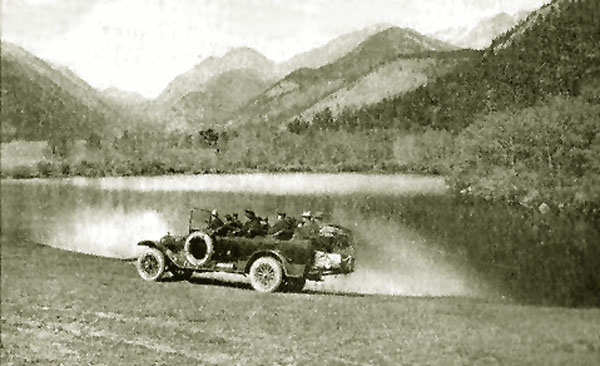
"We ride through a senic wonderland in a comfortable high-powered motor stage."
For the first two years, the Brooks Lake Lodge was a sucess, but with increasing numbers of person visiting yellowstone by motor car and the grueling two day trip from Lander to the Park, business declined.
The road to the Park was indeed, grueling. At times in the summer it was necessary to put chains on the tires in order for motor stages to make it through the gumbo. For discussion of gumbo, see
Lusk. Gradually, the road was improved and the
White busses could make it through in one day with discontinuance of the overnight stay at the Brooks Lake Lodge.
One of the original incorporators with Amoetti, James Gratiot of Casper, took over the operation, renamed it the "Diamond G," and converted it to a dude ranch. The rates were $65.00 per week.
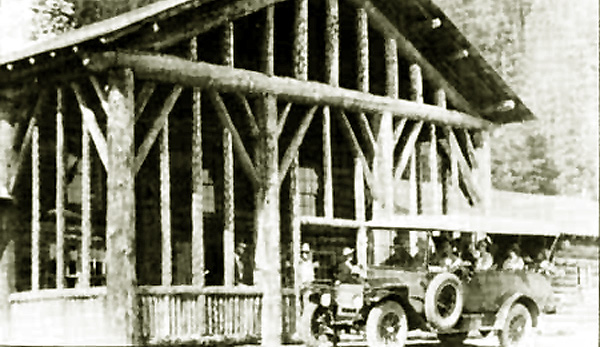
Motor Stage in front of Diamond G. Lodge.
The Lodge remains in business but has but again been renamed as the Brooks Lake Lodge. Conflicts, previously noted with
wildlife, however, continue, particularly with the reintroduction of wolves who seem to have a predilection for dining on the Lodge's livestock.
Music this Page: "Among the Pines," courtesy of Horse Creek Cowboy
Next Page: Dubois continued, Tie Hacks.
|

 . . .
. . .





